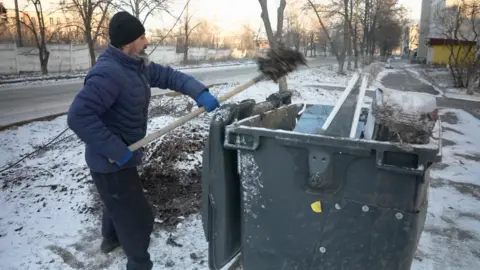Ukraine war: The Christmas ceasefire that wasn't
The drive from Kostyantynivka to Bakhmut is like dropping off a cliff of civilisation.
The "pops" of outgoing tank fire tell you you're getting close to one of the most active parts of the front line in the eastern Donbas region of Ukraine.
They also show that Russia's declared 36-hour ceasefire is in name only.
"They promised there would be one, but we don't see or feel it," says Oleksandr, a Ukrainian soldier.
The constant bangs of incoming artillery reinforce his point. Then, a shell lands 50 metres away from where we are speaking.
I jump. Oleksandr doesn't flinch. "What is it all for?" he asks. A perfectly reasonable question while standing in the almost destroyed main square.

"Everything is being ruined. Civilians are killed, soldiers are killed, our people are dying."
Russian forces are on the eastern edge of the city a little over a mile away. They've thrown everything at trying to take Bakhmut since the summer in an attempt to push further west, but the city hasn't fallen.
On Thursday, Vladimir Putin announced a ceasefire which he said his troops would observe across the front line.
It would run from Friday at midday until midnight on Saturday. He claimed it was so Orthodox Christians could celebrate Christmas.
Ukraine almost immediately rejected it. It certainly doesn't seem like a day worth marking for those left in Bakhmut.
As he rakes leaves into a bin, Sergiy - a civilian - proves me wrong.
"You wouldn't wish this even to your enemy, but we've celebrated Christmas as usual," he says.
"We had a Christmas tree and decorations, but it was in the basement though."

You don't expect to meet anyone who isn't a soldier inside the city. Only a couple of thousand people are left here out of an original population of 50,000.
Military vehicles drive with urgency along the icy roads. We can't stay in the same place for more than five minutes. Hanging around would make us a target.
It's hard to imagine the shelling being more intense, but Sergiy claims it's relatively calm.
"Do you see that missing roof?" he asks. "That was loud. Where the bus depot was hit, that was loud. When this lamp post was hit, that was loud. So, this is quiet."


As a tip of the iceberg, Vladimir Putin's declaration of a truce was significant. It's the first time such language has been used by either side since the start of the full-scale invasion.
Eastern Ukraine, however, is no stranger to war. It's been the focal point of Russia's aggression since 2014 after Moscow first backed separatist militants here.
There have been numerous attempted ceasefires over the years too. Most have failed, and few in Bakhmut expected any respite on this occasion.
Additional reporting by Siobhan Leahy, Hanna Chornous, Paul Francis and Artem Bilov
